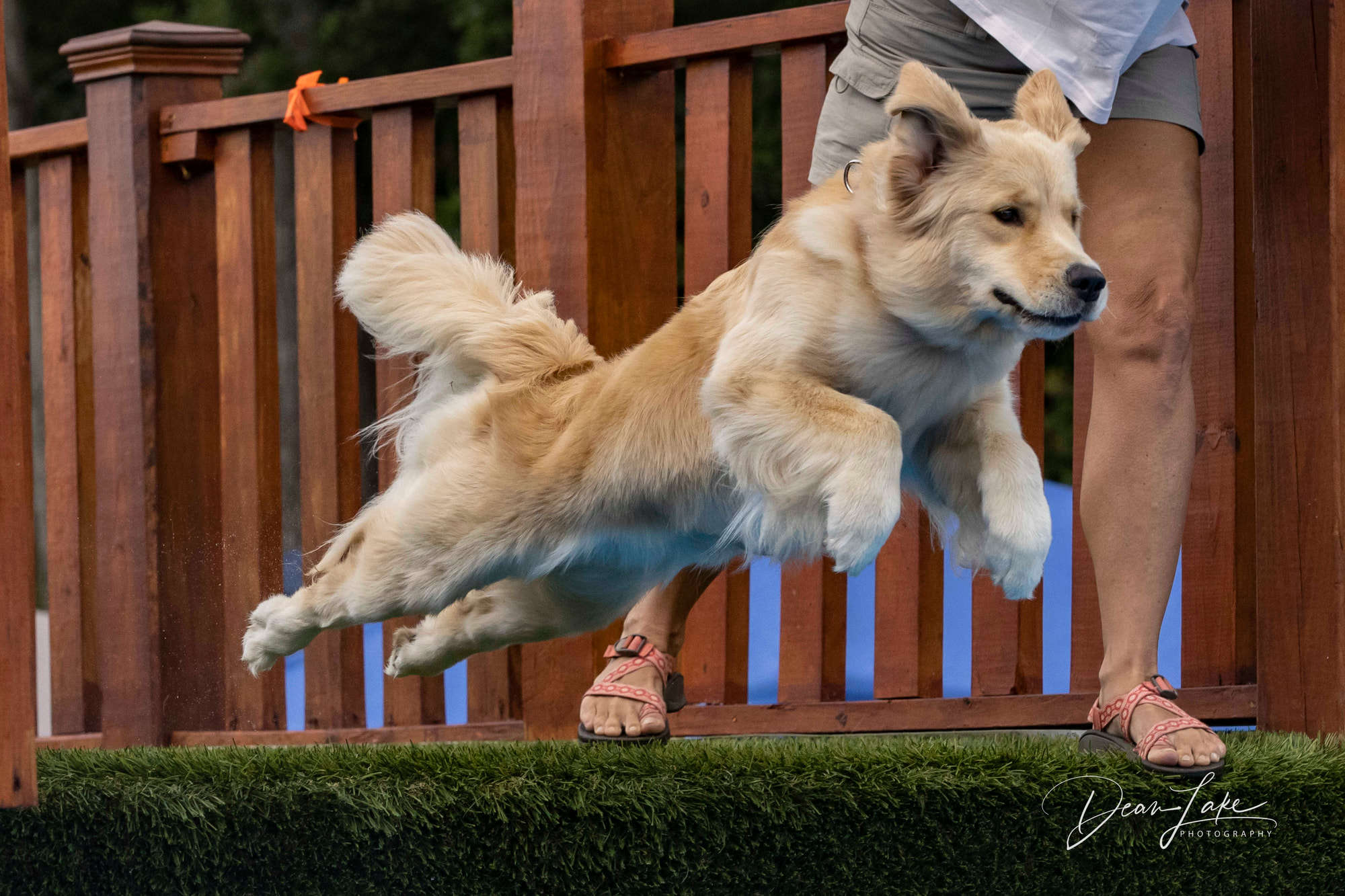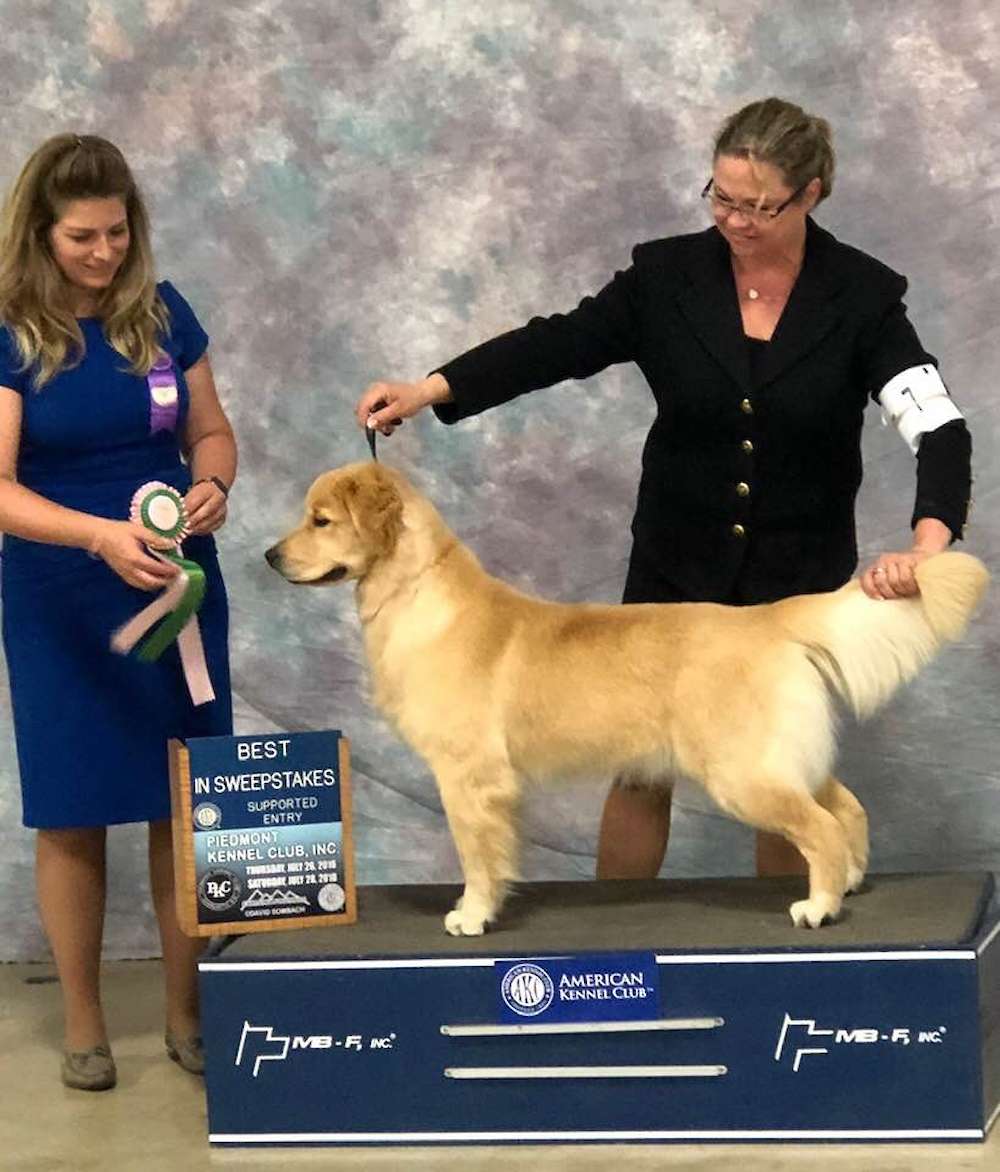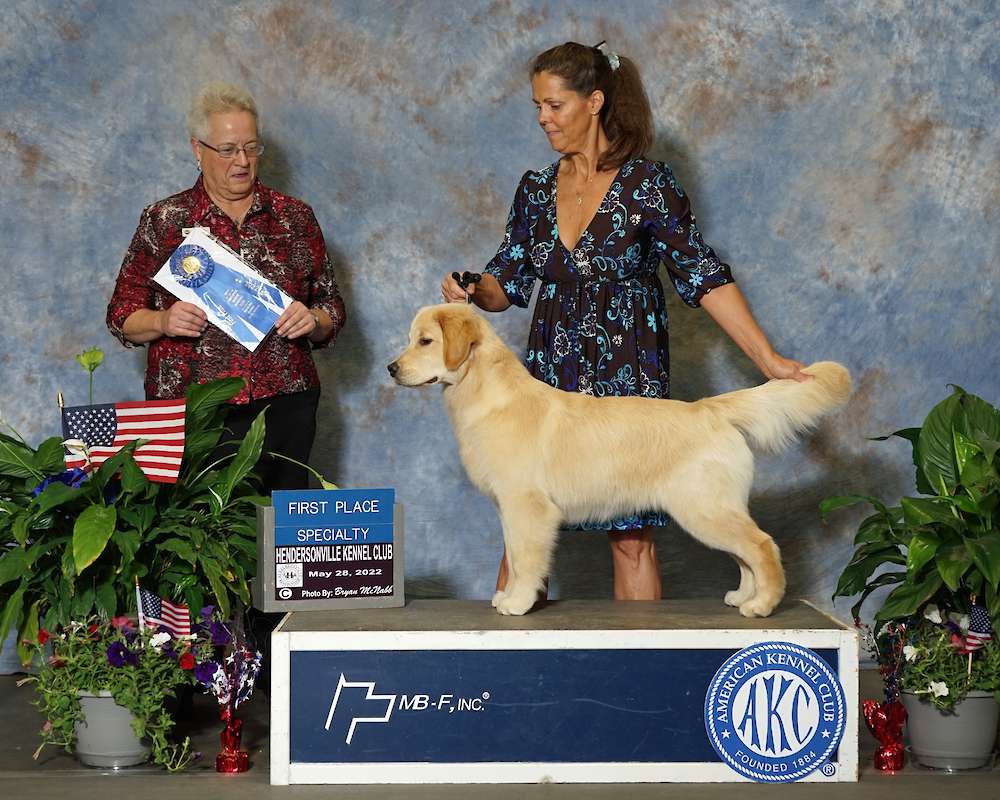
Friendly, Intelligent and Loyal
From a chubby ball of golden fluff to a beautiful, graceful, and elegant looking dog, Golden Retriever characteristics are unmatched!


Powderhorn Run For The Roses "Tilly" BISS TK1 CGC DJ
Passion N Powderhorn Only Game In Town X Powderhorn Won't Back Down

Can GCH, Am BIS Puppy
Goodlife's Driving Miss Daisy "Piper"
TKI CGCU CGCA CCA BISS
Goodlife's Duff The Magic Dragon X Goodlife's How Deep Is Your Love?

Argos Time Two Shine "Bertie" TK1 CGCA
Starrise N Powderhorn Not My First Rodeo X Goodlife's Driving Miss Daisy "Piper"
Frequently Asked Questions
- Are your dogs health tested?
ABSOLUTELY!
The OFA, working with the breed's parent club, recommends the following basic health screening tests for all breeding stock. Dogs meeting these basic health screening requirements will be issued Canine Health Information Center (CHIC) numbers.
Each of our dogs has a link to the K9data showing test results.
Tests that are performed:
Echocardiogram The examiner must be able to perform two-dimensional, pulsed-wave Doppler, and continuous-wave Doppler examinations of the heart. The availability of color Doppler is valuable but not essential for most examinations. The echocardiographic examination should be performed and interpreted by individuals with advanced training in cardiac diagnosis. Board certification by the American College of Veterinary Internal Medicine, Specialty of Cardiology is considered by the American College of Veterinary Medical Association as the benchmark of clinical proficiency for veterinarians in clinical cardiology, and examination by a Diplomate of this Specialty Board is recommended. Other veterinarians may be able to perform these examinations provided they have the appropriate equipment and have received advanced training in echocardiography.
Hips and Elbows Radiographs submitted to the OFA should follow the American Veterinary Medical Association recommendations for positioning. This view is accepted world wide for detection and assessment of hip joint irregularities and secondary arthritic hip joint changes. To obtain this view, the animal must be placed on its back in dorsal recumbency with the rear limbs extended and parallel to each other. The knees (stifles) are rotated internally and the pelvis is symmetric. Chemical restraint (anesthesia) to the point of relaxation is recommended. For elbows, the animal is placed on its side and the respective elbow is placed in an extreme flexed position.
The radiograph must be permanently identified with the animal’s registration number or name, the date the radiograph was taken, and the veterinarian’s name or hospital name.
Eyes Genetic diseases are those that are passed on from parent to offspring through genes that carry the codes for each specific trait. Many of the diseases and disorders that affect the eyes have genetic factors. OFA Eye Certification examinations are screening exams performed by board certified veterinary ophthalmologists. The exam is performed 30 to 40 minutes after pupil-dilating drops are placed in the eyes. The Eye Certification exam consists of indirect ophthalmoscopy and slit lamp biomicroscopy. It is not a comprehensive ocular health examination, but rather an eye screening exam. For example, Eye Certification exams do not entail measuring tear production, staining the eyes for the presence of corneal ulcers, or measuring intraocular pressures. Gonioscopy, tonometry, Schirmer tear test, electroretinography, and ultrasonography are not routinely performed; thus, dogs with goniodysgenesis, glaucoma, keratoconjunctivitis sicca, early lens luxation/subluxation or some early cases of progressive retinal atrophy might not be detected without further testing. If a serious ocular health problem (such as glaucoma) is suspected during the Eye Certification exam, the examiner will recommend a more comprehensive ocular examination. The diagnoses obtained during an OFA Companion Animal Eye Registry exam refer only to the observable phenotype (clinical appearance) of an animal. Thus it is possible for a clinically normal animal to be a carrier (abnormal genotype) of genetic abnormalities.
Embark DNA Testing for genetic diversity, health conditions, and traits. Degenerative Myelopathy, DM Golden Retriever Progressive Retinal Atrophy 1, GR-PRA1 Golden Retriever Progressive Retinal Atrophy 2, GR-PRA2 Ichthyosis, ICH1 Muscular Dystrophy Progressive Retinal Atrophy, prcd Congenital Myasthenic Syndrome, CMS Dystrophic Epidermolysis Bullosa Neuronal Ceroid Lipofuscinosis 5, NCL 5 Osteogenesis Imperfecta, Brittle Bone Disease Retina Dysplasia and/or Optic Nerve Hypoplasia
- How do I go about getting an Argos Golden?
1. Complete and return Puppy Questionnaire, please be thorough as this help determine puppy placement. Puppy application cannot be completed on a smart phone (sorry) you will need to complete it on your computer.
2. Once puppies are born I will reach out to schedule a phone conversation.
3. If there is a mutual agreement that Argos Golden is the right fit and we are able to accommodate your request for a puppy, your deposit will be required at this time, with a signed copy of the contract.
.
- What if I don't want a "show dog"?
BUT I DON'T WANT A SHOW DOG!
Why do people recommend choosing a breeder who shows their dogs to folks who are just looking for a pet and have no interest in showing? Why should breeding to breed standard be important to a pet home? Does it seem excessive, or “snobby”?
It’s not, and here’s why.
Dog shows are a means of evaluating dogs against the breed standard, to evaluate soundness, movement/gait, type, and temperament.
Soundness: The state of physical and mental health when all organs and faculties are functioning properly, each in its rightful relation to each other.
Type: Breed type encompasses appearance, character, condition, bone structure, temperament, and movement; "breed type is all these things." Breed type also includes a character specific to each breed, a combination of behavior, temperament and carriage that demonstrate an essence of the breed.
Gait: The gait of a dog is its quality of movement. You want to see ease of movement, unimpaired by illness or poor structure.
Temperament: The general attitude a dog has towards other animals and people. The ideal disposition is one of a kindly, outgoing, tractable nature; eager to please and non-aggressive towards man or animal. The Golden has much that appeals to people; his gentle ways, intelligence and adaptability make him an ideal dog. Aggressiveness towards humans or other animals, or any evidence of shyness in an adult should be severely penalized."
So. That’s a very basic intro to what goes on at a show... why does this matter? You want a pet, a companion, not a show dog, right? Well, you chose a Golden for a reason. You’ve done your research, and have read that they’re great with kids and other animals, they’re gentle, not aggressive, they make excellent companions and love spending time with their people. That their good and kind nature predisposes many Goldens to be excellent therapy dogs. Good, responsible breeders seek to preserve those definitive and positive characteristics.
What about type and structure? How the dog is put together, able to move freely and comfortably? Would you rather buy from someone who has proven publicly, over time, that the dog they’re breeding can move well, free of limp, or a structural problem? Or just trust someone who has no interest in proving their dogs? It’s your puppy’s quality of life and comfort (as well as your wallet) that’s at stake.
Not every dog in a well-bred litter is going to be show quality- there will ALWAYS be pet-quality puppies. Well-bred, but maybe with a slight imperfection, and those are the puppies placed in pet homes. You don’t have to want a show-quality puppy to get a well-bred puppy!
This is not about being snobby, being elitist, thinking that one dog is “better” than another, it’s about ensuring you get a puppy that acts and looks like the breed you fell in love with. It’s about ensuring that all puppies have the best start in life, and will grow into a loving family member. It’s about loving our breed enough to want to see everything that’s good about them preserved for future generations to enjoy. If you want a healthy dog, with a properly sweet temperament, choose your breeder wisely!
This was authored by Terri Lewin Gilbert. Please direct any inquiries to her if you have any questions about sharing it on any other media.
lewintn@gmail.com
- Do I get to pick the puppy I want?
The simple answer to that is no. You decide what sex you would want.
I will do an aptitude test called The Volhard Pet Aptitude Test on the puppy to help determine which puppy will be placed with each family.
WHAT IS PUPPY TESTING?
Some of the tests we use were developed as long ago as the l930’s for dogs bred to become Guide Dogs. Then in the 1950’s, studies on puppies were done to determine how quickly they learned. These studies were actually done to identify children’s learning stages.
Top Dog Tips: The ideal age to test the puppy is at 49 days of age when the puppy is neurologically complete and it has the brain of an adult dog. With each passing day after the 49th day the responses will be tainted by prior learning.
Later on in the early 60’s more tests were developed to determine if pups could be tested for dominance and submission. These tests determined that it was indeed possible to predict future behavioral traits of adult dogs by testing puppies at 49 days of age. Testing before or after that age affected the accuracy of the test, depending on the time before or after the 49th day.
We took these tests, added some of our own, and put together what is now known as the Volhard Puppy Aptitude Test, or PAT. PAT uses a scoring system from 1-6 and consists of ten tests. The tests are done consecutively and in the order listed. Each test is scored separately, and interpreted on its own merits. The scores are not averaged, and there are no winners or losers. The entire purpose is to select the right puppy for the right home.
The test are as follows:• Social Attraction - degree of social attraction to people, confidence or dependence.
• Following - willingness to follow a person.
• Restraint - degree of dominant or submissive tendency, and ease of handling in difficult situations.
• Social Dominance - degree of acceptance of social dominance by a person.
• Elevation - degree of accepting dominance while in a position of no control, such as at the veterinarian or groomer.
• Retrieving - degree of willingness to do something for you. Together with Social Attraction and Following a key indicator for ease or difficulty in training.
• Touch Sensitivity - degree of sensitivity to touch and a key indicator to the type of training equipment required.
• Sound Sensitivity - degree of sensitivity to sound, such as loud noises or thunderstorms.
• Sight Sensitivity - degree of response to a moving object, such as chasing bicycles, children or squirrels.
• Stability - degree of startle response to a strange object.During the testing make a note of the heart rate of the pup, which is an indication of how it deals with stress, as well as its energy level. Puppies come with high, medium or low energy levels. You have to decide for yourself, which suits your life style. Dogs with high energy levels need a great deal of exercise, and will get into mischief if this energy is not channeled into the right direction.
Finally, look at the overall structure of the puppy. You see what you get at 49 days age. If the pup has strong and straight front and back legs, with all four feet pointing in the same direction, it will grow up that way, provided you give it the proper diet and environment in which to grow. If you notice something out of the ordinary at this age, it will stay with puppy for the rest of its life. He will not grow out of it.
- Puppy Development and Stimulation
Before your puppy goes home with you it will have experienced many interaction with people and situations.
Grooming: Your puppy will have had many baths along with being placed on a table for drying and grooming. Nails will have been trimmed weekly from week 2 of age. Starting with a clipper and ending with a dremmel tool.
Potty training: Potty training starts early at 4 weeks of age.
Crate training: Your puppy will have a great head start on getting used to a crate and will have taken many naps in the crate by itself. Crate training is VERY important for the safety of your puppy.
Food: Your puppy will have been fed Royal Canin puppy food for Golden Retrievers.
Socialization: Your puppy will have been exposed to many different people, noises, smells and situations. My goal is for you to have a even tempered, well socialized puppy.